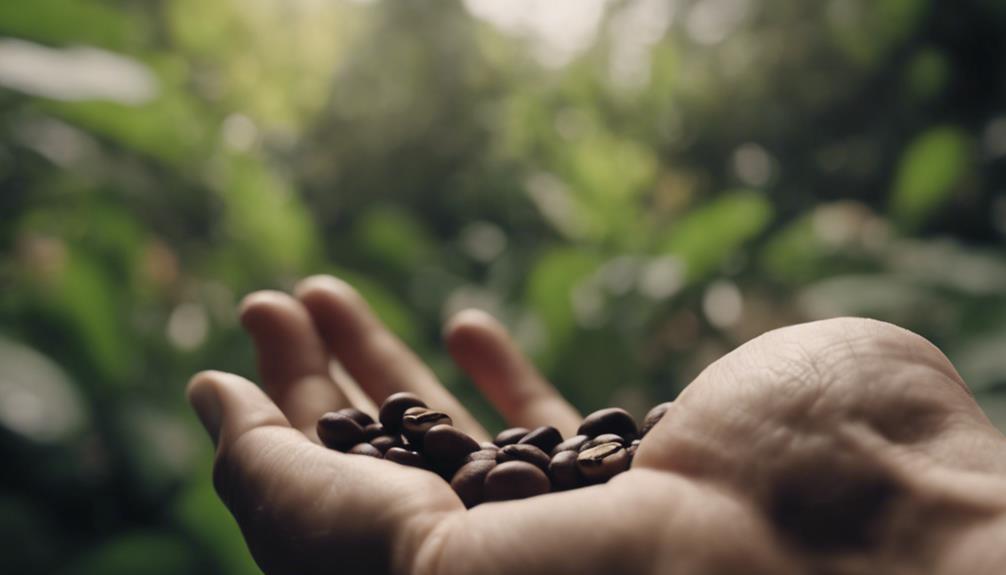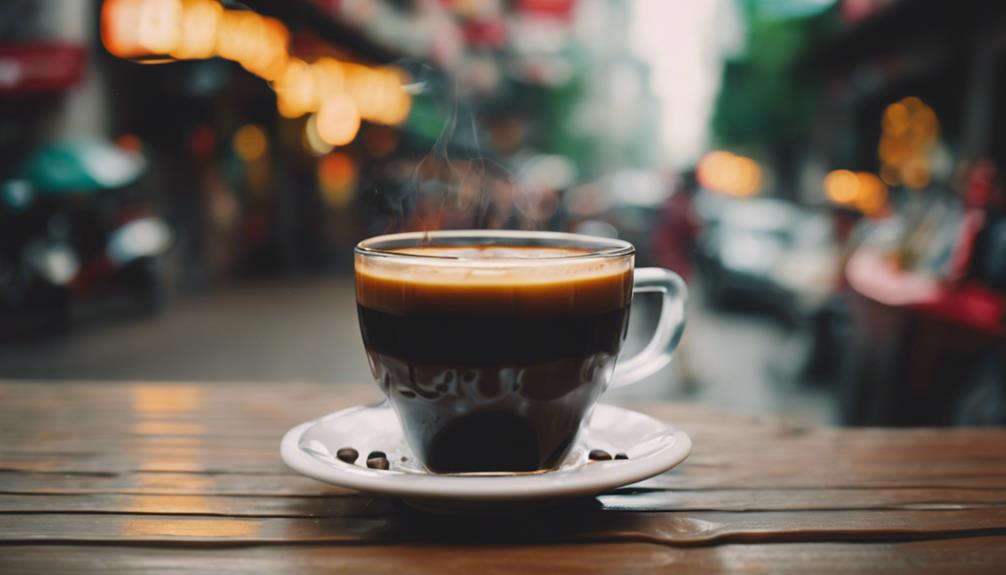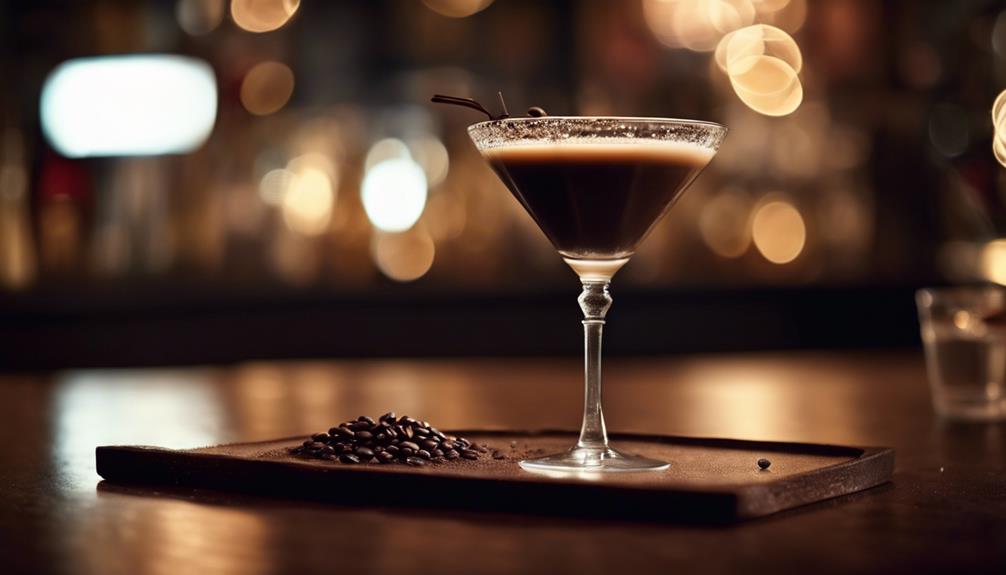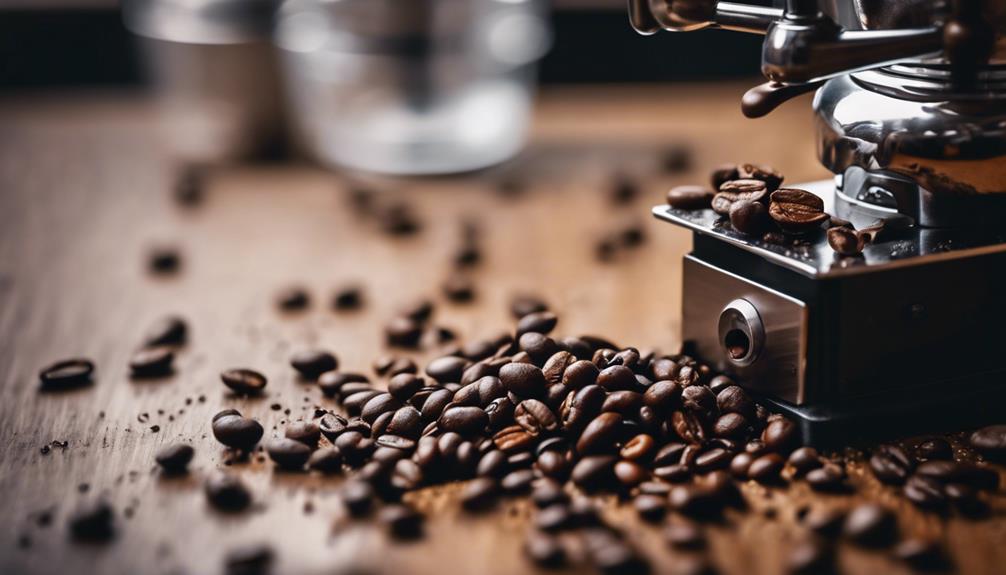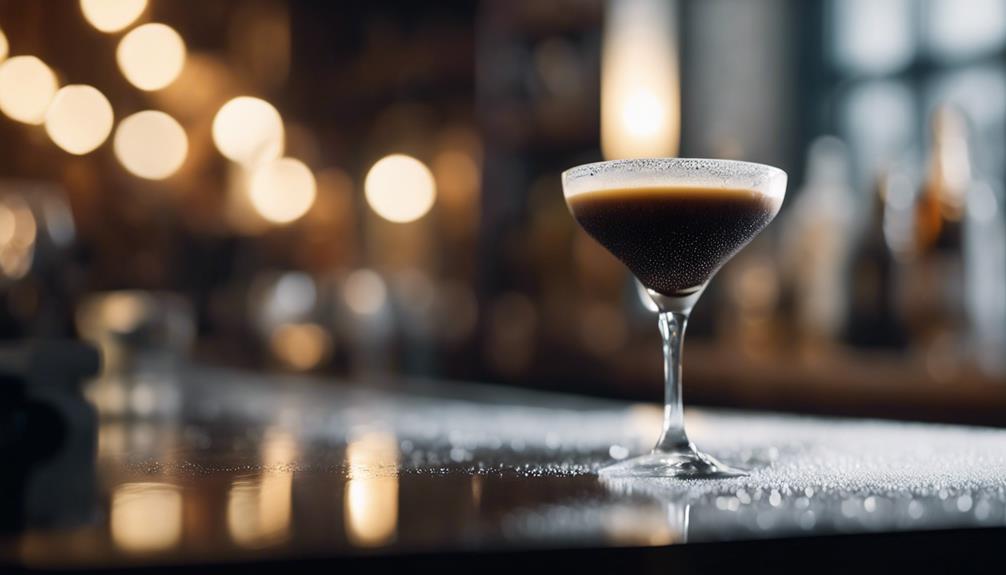Eating espresso beans can provide you with a much-needed energy boost. These beans are loaded with caffeine, which can quickly revitalize you. Each espresso bean contains approximately 12mg of caffeine. Just consuming 11 beans equals the caffeine content in two cups of coffee. They act fast to increase your energy levels. However, it is important to enjoy them in moderation to prevent feeling jittery. The caffeine helps keep you attentive and focused. Furthermore, the release of dopamine gives you the motivation you need. Consume these beans responsibly for a convenient energy boost.
Key Takeaways
- Eating espresso beans provides a potent energy boost.
- Espresso beans contain caffeine for increased alertness.
- Eleven beans equal the caffeine in two cups of coffee.
- Rapid absorption of caffeine for a quick pick-me-up.
- Enjoy espresso beans responsibly for effective energy enhancement.
Energy Boost From Espresso Beans
For a vital and potent energy boost, indulging in espresso beans can be a game-changer in your day. These small but mighty beans pack a punch of caffeine, perfect for increasing alertness and jumpstarting your morning.
Just eleven espresso beans are equivalent to consuming two cups of coffee, making them a convenient way to get your caffeine fix. The caffeine in espresso beans is rapidly absorbed by your body, providing a quick pick-me-up when you need it most.
Whether you're looking to power through a busy morning or combat the afternoon slump, consuming espresso beans can help you stay focused and energized. However, it's important to remember that moderation is key.
While espresso beans can be a great tool for boosting your energy levels, overindulging can lead to potential side effects. So, enjoy your espresso beans responsibly to make the most of their energizing benefits without the drawbacks.
Caffeine Content in Espresso Beans

Espresso beans are packed with caffeine, with just eleven beans equivalent to the caffeine in two cups of coffee.
This high caffeine content leads to a rapid absorption rate in your body, resulting in heightened alertness and energy levels.
Remember to consume espresso beans in moderation to avoid potential side effects from excessive caffeine intake.
Caffeine Levels Comparison
Comparing the caffeine content in espresso beans to other caffeinated sources reveals their significance in providing a quick energy boost. A single espresso bean contains approximately 12mg of caffeine, similar to a small sip of coffee.
Munching on eleven espresso beans equates to consuming around two cups of coffee in relation to caffeine intake. The caffeine in espresso beans is rapidly absorbed by your body, leading to a swift surge in energy levels.
However, it's important to exercise moderation when indulging in espresso beans to steer clear of potential side effects stemming from excessive caffeine consumption. By understanding the caffeine levels in espresso beans and how they compare to traditional coffee sources, you can gauge the amount needed to achieve that quick energy boost without overdoing it.
Espresso Bean Effects
Indulging in espresso beans can quickly boost your energy levels due to their high caffeine content. The caffeine in espresso beans contributes to increased alertness, providing a rapid energy increase.
Here are some key points to take into account when it comes to the effects of espresso beans:
- Caffeine Content: Each espresso bean contains around 12 milligrams of caffeine, making them a potent source of quick energy.
- Equivalent to Coffee: Consuming eleven espresso beans is equivalent to the caffeine content of two cups of coffee, giving you a similar energy boost.
- Moderation is Essential: To avoid potential side effects from high caffeine intake, it's essential to consume espresso beans in moderation.
While they can provide a quick energy increase, excessive consumption can lead to jitters, restlessness, and even heart palpitations.
Be mindful of your caffeine intake and enjoy espresso beans responsibly for an effective energy boost.
Alertness and Productivity Benefits

Eating espresso beans can help boost your alertness and productivity levels. The caffeine present in these beans can enhance your mental focus and wakefulness, leading to improved cognitive performance.
Enjoying espresso beans in moderation throughout the day can provide a natural source of energy, combating fatigue and keeping you sharp.
Increased Alertness Levels
Enhance your alertness and productivity by consuming espresso beans, thanks to their high caffeine content. When you eat espresso beans, you can experience a quick energy boost that helps combat drowsiness and promotes wakefulness.
The caffeine present in espresso beans plays an essential role in enhancing your alertness levels and boosting your focus. Here are some key ways in which consuming espresso beans can increase your alertness and productivity:
- Quick Energy Boost: Espresso beans provide a rapid energy surge, similar to drinking a cup of coffee, helping you stay alert and focused.
- Enhanced Focus: The caffeine content in espresso beans can sharpen your focus, making it easier to concentrate on tasks and remain productive throughout the day.
- Combat Drowsiness: By consuming espresso beans, you can effectively fight off drowsiness and maintain a higher level of wakefulness, improving your overall cognitive performance.
Enhanced Productivity Levels
Boost your productivity levels by incorporating espresso beans into your daily routine, taking advantage of their alertness and productivity benefits. Espresso beans provide a quick energy boost, thanks to their high caffeine content.
This caffeine not only improves alertness but also enhances focus, leading to enhanced productivity levels. By stimulating the central nervous system, espresso beans promote wakefulness and mental clarity, helping you stay sharp and attentive throughout the day.
The energy boost from consuming espresso beans is akin to that of drinking coffee, offering a convenient source of energy that you can enjoy on the go. Combatting fatigue and drowsiness, these beans can be a handy snack to keep you energized and focused on your tasks.
Incorporating espresso beans into your routine can help you tackle your daily responsibilities with increased vigor and efficiency, making them a valuable addition to your productivity toolkit.
Dopamine Levels and Wakefulness
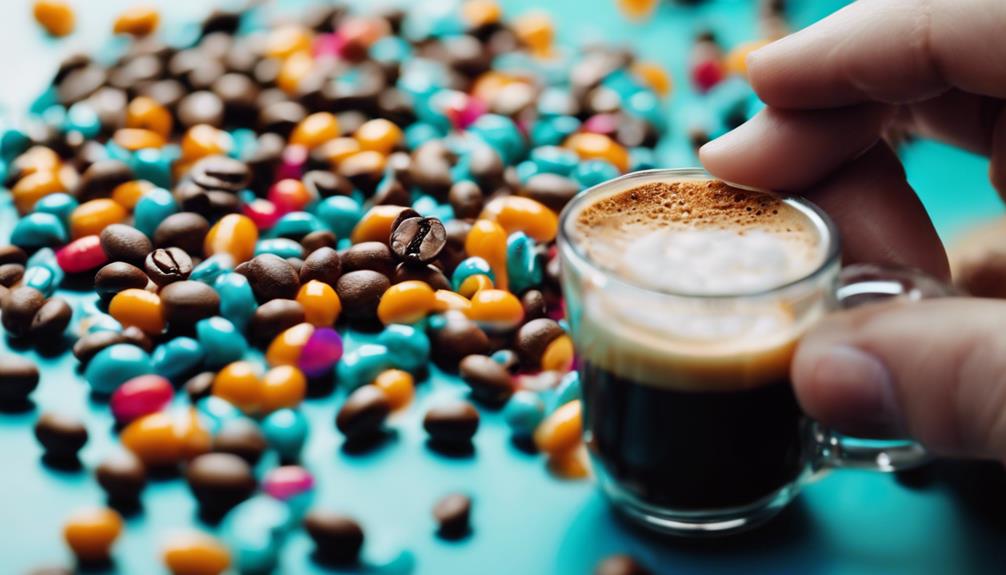
Boosting dopamine levels through the consumption of espresso beans can significantly enhance wakefulness and alertness. When you eat espresso beans, the caffeine within them stimulates the release of dopamine in your brain, a neurotransmitter associated with pleasure and reward.
This interaction between caffeine and dopamine can lead to improved focus and mental clarity, making you feel more energized and motivated. The combination of these effects from espresso beans can help combat fatigue and enhance overall cognitive function.
Benefits of Eating Espresso Beans

When looking at the advantages of consuming espresso beans, consider the important energy boost they provide due to their caffeine content. Each espresso bean contains around 12mg of caffeine, akin to a small sip of coffee.
Eating eleven espresso beans equals the caffeine intake of two cups of coffee. This makes espresso beans a convenient source of energy, often chosen as a morning pick-me-up.
However, it's essential to practice moderation when consuming espresso beans to steer clear of potential side effects from excessive caffeine intake. While they offer a quick energy fix, overindulgence can lead to jitteriness, increased heart rate, or disrupted sleep.
Snacking on Chocolate-Covered Beans
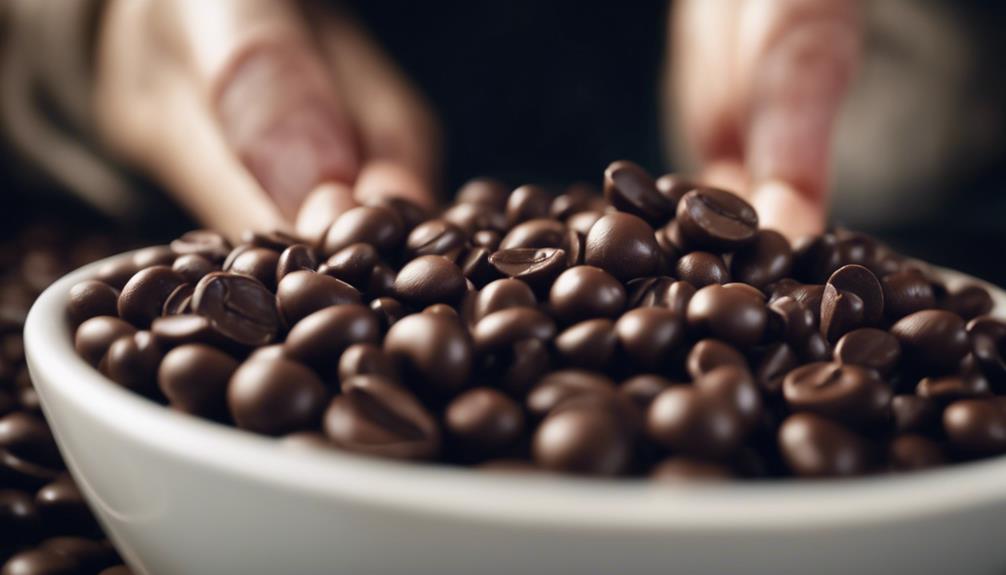
Indulging in chocolate-covered espresso beans offers a delightful combination of flavors and an energizing snack option. Here are some facts to keep in mind:
- Energy Boost: The caffeine content in chocolate-covered espresso beans can provide a quick energy boost, making them a perfect pick-me-up during the day.
- Sweet Snack: The blend of chocolate and espresso beans not only gives a satisfying sweetness but also delivers a dose of caffeine for that extra kick.
- Moderation is Key: While these beans can offer a quick energy fix, it's important to consume them in moderation. Overindulgence may lead to jitteriness or disrupted sleep patterns.
Snacking on chocolate-covered espresso beans can be a tasty way to get a quick energy boost with the added benefits of chocolate and coffee. Remember to enjoy them in moderation to maintain sustained energy levels throughout the day.
Convenient Energy Source
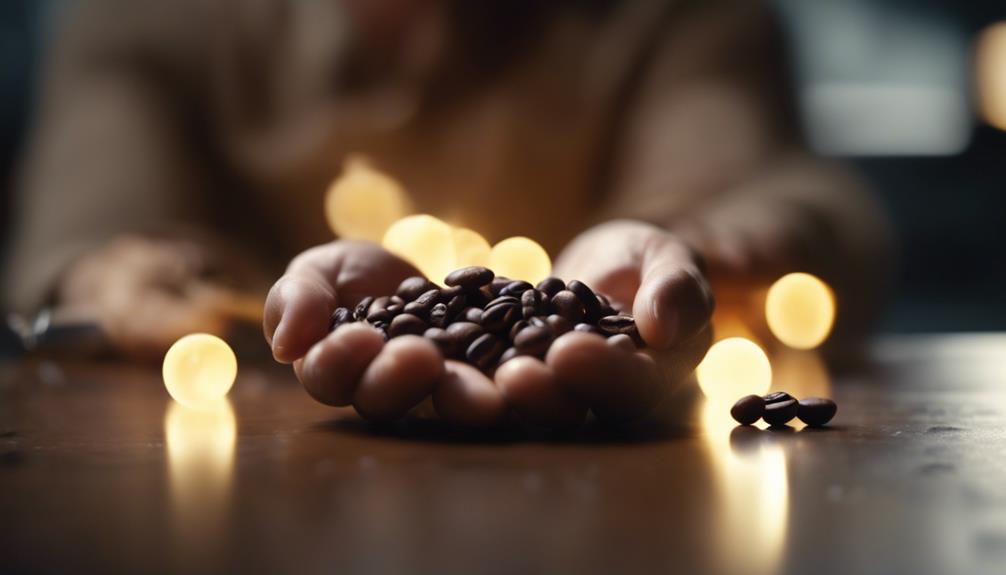
For a quick and convenient energy source, consider snacking on espresso beans as a natural pick-me-up. These beans pack a punch with their caffeine content, offering an effective way to boost alertness and energy levels. Each espresso bean contains approximately 12 milligrams of caffeine, making them a handy option for a quick pick-me-up during busy days. In fact, consuming just eleven espresso beans is akin to ingesting the caffeine found in two cups of coffee.
To help you visualize the caffeine content in espresso beans compared to coffee, take a look at the table below:
| Espresso Beans | Caffeine Content (per bean) |
|---|---|
| 1 Bean | 12 mg |
| 11 Beans | 132 mg |
| 1 Cup of Coffee | Around 95 mg |
Enjoying espresso beans in moderation is key to reaping their benefits while avoiding overconsumption. With their convenient size and potent caffeine content, these beans can be a practical and efficient way to stay energized throughout the day.
Frequently Asked Questions
Does Eating Espresso Beans Give You Caffeine?
Yes, eating espresso beans does give you caffeine. Each espresso bean contains approximately 12mg of caffeine, offering a quick energy boost.
Consuming eleven beans equals the caffeine in two cups of coffee. The caffeine in espresso beans acts as a natural stimulant, promoting increased energy levels and mental alertness.
How Many Espresso Beans Should I Eat for Energy?
For an energy boost from espresso beans, start with around eleven beans, equivalent to two cups of coffee.
Each arabica bean contains about two milligrams of caffeine, which is released into your body for increased alertness.
Remember, moderation is key to avoid potential side effects, especially if you're new to consuming espresso beans for energy.
Gradually introduce them into your routine to assess your tolerance and maximize benefits.
Can You Eat Espresso Beans as a Snack?
Yes, you can eat espresso beans as a snack. They offer a convenient way to get a quick caffeine boost on the go.
With their high caffeine content, espresso beans can help enhance your focus and alertness. Remember, moderation is important to prevent consuming too much caffeine.
Enjoy them as a handy pick-me-up during the day, but be mindful of your intake to avoid overdoing it.
Does Swallowing Coffee Beans Give You Energy?
Swallowing coffee beans can indeed give you a noticeable energy boost. When you chew and swallow coffee beans, the caffeine they contain is absorbed rapidly into your bloodstream.
This can lead to a quick increase in energy levels, similar to drinking a cup of coffee. Consuming coffee beans whole provides a concentrated dose of caffeine, making it an effective way to get a quick pick-me-up when you need it.
Is Eating Espresso Beans an Effective Way to Get Energy?
Eating espresso beans can provide a quick espresso beans energy boost due to their high caffeine content. However, consuming too many can lead to jitters and insomnia. It’s best to moderate your intake and pair them with a balanced diet for a more sustainable energy source.
Conclusion
To sum up, eating espresso beans can provide a quick and convenient energy boost due to their high caffeine content. It's like having a power-up for your day, helping you stay alert and productive.
Whether you enjoy them on their own or as a tasty snack, these beans can be a helpful pick-me-up when you need a little extra boost. Just remember to consume them in moderation to avoid any potential side effects.
